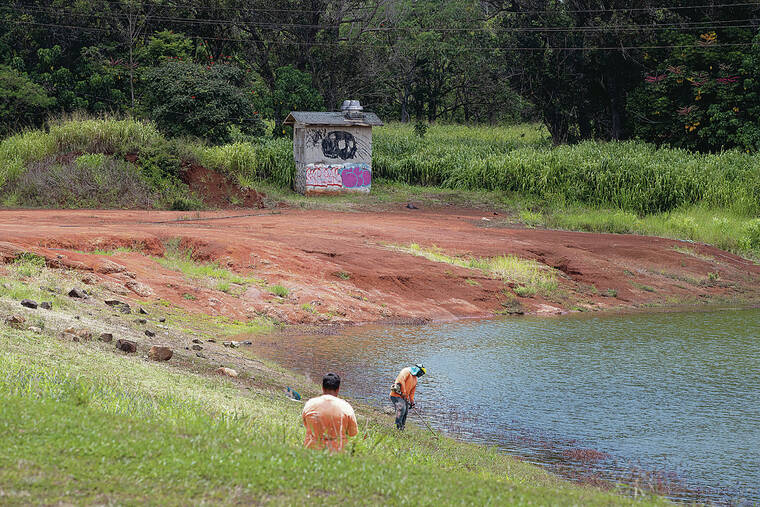By Andrew Gomes
Copyright staradvertiser

Over 30 years ago, state leaders saw a need to take over Hawaii plantation-era water systems and fallow farmland to support diversified agriculture, and now one such water system that’s become a drain on Maui’s economy is for sale.
But a state agency created to acquire this kind of property may or may not be a good fit for the century-old Maui system, which has financially strained its private owner and hasn’t delivered sufficient water to users including farms, residential communities, two golf courses and Maui County over the last year in part due to damage.
That agency, the Agribusiness Development Corp., is in the midst of producing a statewide strategic plan that includes identifying agricultural lands for acquisition, strengthening diversified agriculture on former plantation lands and investing in infrastructure that delivers economic, environmental and community benefits.
ADC also recognizes that reliable water is a much bigger public safety issue after the 2023 Maui wildfire, which partly raged across dry vegetation on fallow farmland, killed 102 people and destroyed most of Lahaina.
“As the monocrop industries have exited the state, many water systems have experienced neglected maintenance and disrepair at a time when wildfire mitigation and drought conditions are on the rise,” the agency said in its 2024 annual report.
On Oct. 16, ADC plans to hold a board meeting on Maui for the first time ever, and is expected to hear public concerns about little water, which is also due to drought, running through the system owned by Maui Land & Pineapple Co.
MLP developed the system about 100 years ago with sugarcane producer Pioneer Mill Co. to divert water from Honokohau Stream in the mountains to their drier plantation lands below. The system, often referred to as the Honokohau Ditch System, includes 7 miles of mainly tunnels connected to reservoirs, gates and other infrastructure.
Pioneer Mill closed in 2000, and MLP ceased pineapple farming in 2009.
MLP has said that factors including drought, state stream flow standards and irreparable damage caused by heavy rain associated with Hurricane Lane in 2018 have contributed to an insufficient water supply this year.
At least a few members of Hawaii’s Legislature are considering whether the state should help acquire the system after the water constraints led to the closure of two Kapalua golf courses recently and cancellation of a PGA Tour golf tournament in January worth an estimated $50 million to Maui’s economy.
Yet those same lawmakers don’t see ADC as a good candidate for taking over the system.
Sen. Angus McKelvey, who represents West Maui, said ADC could possibly play a supporting role, but in his view Maui County is best positioned to acquire the system because agriculture is only one part of the customer base for the water.
“It has to be a partnership with the county as the tip of the spear,” he said.
MLP wants to sell its water system assets, which also include groundwater wells, and has had preliminary discussions with county officials.
MLP CEO Race Randle said in a statement, “Delivering water our local families and farmers need is a fundamental factor in the resilience of our island communities in the future. We fully support the State and Maui County’s continued efforts to invest in land, water distribution, and production facilities to reduce barriers to local food production.”
Sen. Lorraine Inouye, chair of the Senate Water and Land Committee, has had discussions with county leaders and also believes the state could help the county take over the MLP system. But Inouye envisions a better partner in the state Department of Land and Natural Resources.
Dane Wicker, deputy director of the state Department of Business, Economic Development and Tourism, which oversees ADC, said ADC has been monitoring the MLP water situation but isn’t engaged in any active acquisition effort.
“That said, ADC’s strategy is to continue building its agricultural portfolio in all counties as part of its statutory mission,” he said in an email after ADC deferred comment to DBEDT. “The statute tasks ADC with reviewing agricultural lands and infrastructure, including irrigation systems, for potential acquisition when appropriate. This evaluation process is part of a broader effort to expand Hawaii’s agricultural base, support economic diversification, and strengthen food security.”
Agency birth
ADC was born in 1994 largely out of concern over the planned 1995 shutdown of Oahu Sugar Co., and was proposed by then-Gov. John Waihee.
The agency’s first acquisition was the Waiahole ditch water system in 1999. ADC bought it from an affiliate of Oahu Sugar for $8.5 million appropriated by the Legislature.
This 26-mile system transports mountain water from Waiahole in Windward Oahu through a tunnel in the Koolau Mountains to about 5,900 acres of Leeward Oahu farmland.
ADC also received an initial $1.2 million appropriation to improve the system, which at the time carried more than 15 million gallons of water daily to Leeward farmers.
“By guaranteeing a steady source of water at an affordable price, farmers in Kunia can expand their acreage, hire more workers and double their production of crops,” then-Gov. Ben Cayetano said at the time.
ADC’s next three big acquisitions were in the 2000s on Kauai after sugar plantation closures — 12,000 acres of farmland in Kekaha in 2002 after the shutdown of Amfac/JMB sugar operations, 6,000 acres of former Lihue Plantation lands in 2005 and then water infrastructure that included the Kokee Ditch System and the Kekaha Ditch System in 2009.
In 2012, ADC acquired, at the Legislature’s direction, 1,227 acres of farmland and an irrigation system in Central Oahu near Wahiawa from the George Galbraith Estate after Del Monte quit leasing the lands for pineapple production in 2008.
The agency further expanded holdings around Wahiawa by purchasing more than 2,000 acres of farmland for about $50 million from 2016 to 2019 also at the Legislature’s direction.
ADC offsets expenses by leasing land and delivering water to farmers. The agency in its 2024 fiscal year report said it had 21 employees, including 10 managing the Waiahole and Kauai water systems.
Revenue from the Waiahole system totaled nearly $1.4 million while expenses were almost $1.1 million, including repayment of bonds issued for the purchase, according to the report.
New ADC growth
An even bigger ADC endeavor is underway to improve the old Galbraith irrigation system, which depends on one well limited to 2 million gallons a day and is vulnerable to disruption.
The improvement project estimated to cost $140 million includes tapping two nonpotable water sources — Lake Wilson and the Wahiawa Wastewater Treatment Plant — and developing supportive infrastructure including pump stations, pipelines and a 14 million-gallon reservoir.
Lake Wilson itself, along with a connected ditch system that is the primary source of water for about 17,000 acres of North Shore farmland, also may become ADC assets under a bill that became law in 2023 directing the agency to negotiate a purchase with owner Dole Food Co.
Dole still grows pineapple near Wahiawa, but told lawmakers in 2023 that its operation couldn’t support mandatory dam safety improvements at the lake estimated to cost at least $20 million. Dole also vowed to remove the dam and reservoir, which supplies water through ditches and tunnels to its own farm operations and 50 other farms employing more than 500 people, if the state didn’t acquire the water system infrastructure.
The Legislature appropriated $5 million for the purchase and $21 million to repair and expand the dam spillway, though no sale has been completed yet.
Gov. Josh Green signed the bill in 2023, and said the state needs to secure more water resources in part to improve food security.
“We have to make sure that we can expand this sector,” Green said at the time. “We never go far enough, in my opinion, but this is a start.”
Some critics of ADC contend the agency hasn’t done enough in its mission.
In 2021, the state auditor published an ADC performance audit that said the agency misunderstands its purpose and lacks a strategic plan.
“More than 25 years after its creation, we found an agency that is generally unaware of its unique powers and exemptions, and has done little — if anything — toward achieving its statutory purpose,” the audit said.
Maui system sale
According to MLP, no bills have been introduced previously at the Legislature to have the state acquire the Honokohau Ditch System. However, the state has bought MLP farmland.
The state paid MLP $19.8 million in 2014 for 244 acres in West Maui after lawmakers passed a bill backed by MLP in 2013 to have DLNR acquire the property to protect it from potential development and to shore up pension obligations that MLP was struggling to meet.
Sen. Donovan Dela Cruz, a strong proponent of preserving agriculture in Hawaii, said a state investment in the MLP water system wouldn’t really make sense if the opportunity doesn’t exist to activate farming on fallow land instead of other uses.
In recent history, Maui County has been the biggest recipient of water from MLP’s system, which it treats and then distributes as potable water. Over the last three years, the county on average received 1.2 million gallons a day, and can take up to 2.5 million gallons a day, according to MLP.
TY Management, the owner of the two Kapalua golf courses, had averaged 700,000 gallons per day before shortages over the last year.
MLP also has future obligations to provide 2 million gallons a day for a planned state Department of Hawaiian Home Lands subdivision, and 1 million gallons a day for a developer’s housing project called Pulelehua.
Partly because of these obligations, MLP is working on plans to expand its system capacity with improvements that include increasing reservoir capacity to about 22 million gallons from 12.3 million gallons.
MLP also has said that it aims to increase productive use of its fallow farmland, which is partly constrained by water availability.
During a Sept. 16 state Commission on Water Resource Management meeting, Randle said MLP has historically provided relative little water directly to farm tenants, including at least one banana grower and a community garden that aren’t supported by reservoirs and only receive water when a lower portion of the ditch system is flowing.
Randle said the average delivery for these tenants over the last three years was 50,000 gallons per day.
One farm business enduring reductions and cutoffs of water from MLP’s system is suing MLP with TY Management and three Kapalua homeowner associations.
Hua Momona Farms LLC, which grows field crops, micro-greens, trees, and sod on 25 acres, contends in the complaint filed in August that its crops are at risk of imminent loss.
McKelvey said ADC or other state agencies could be a good partner to help Maui County take over the water system to in part support future farming.
“You talk about diversified local ag,” he said. “Well, without a working water system that’s kind of a pipe dream, right?”



